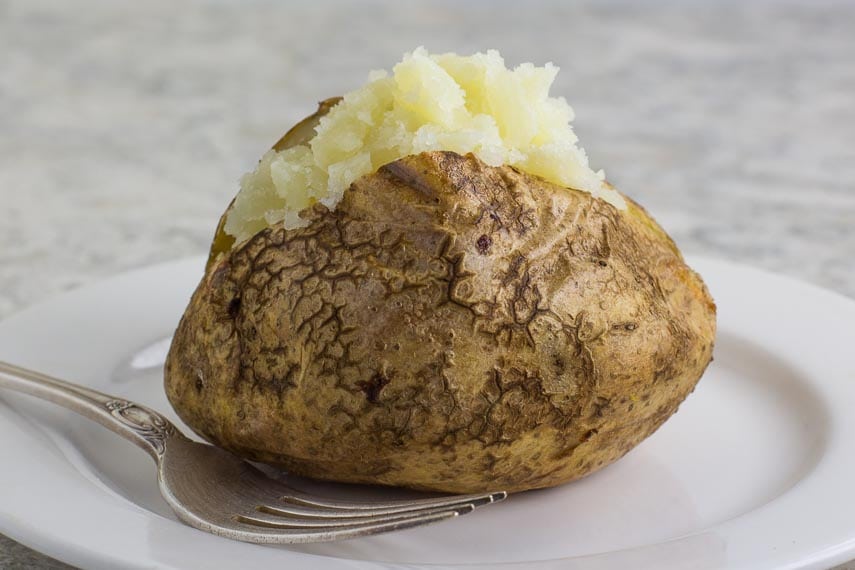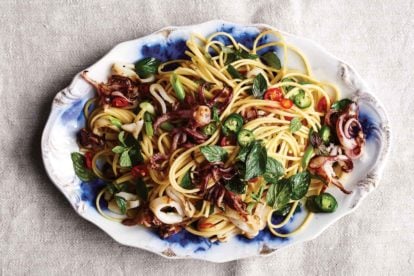Did the title “No FODMAP Baked Potato” get your attention? Potatoes – russet, yellow-skinned, red-skinned and purple – have all been lab tested and contain no FODMAPS! This is great news for those of us preparing meals and working on meal planning.
All About Potatoes
We have a very complete, deep dive into this most popular tuber in our Explore an Ingredient article on Potatoes, and that is a highly recommended read.
The primary thing you need to know is that potatoes have shown no detectable FODMAPs in lab tests, which means that we can incorporate them into our low FODMAP cooking quite readily.
Also note that sweet potatoes do have FODMAP content and details are discussed in the article. There is a low FODMAP serving size of sweet potatoes, so don’t worry!
What Potatoes Makes The Best Baked Potato?
We love potatoes mashed, steamed, smashed, oven-fried, hash browns, potato pancakes, in salad – pretty much any way we can prepare them – and baked potatoes are a classic that we were thrilled to find out that we could continue to enjoy while on the low FODMAP diet.
The best potatoes for baking are floury, starchy baking potatoes, sometimes referred to as russet potatoes or Idaho potatoes (here in the U.S.). Their high starch content yields a fluffy interior.
Save the waxy potatoes for potato salads and other uses.
How To Make Baked Potatoes
There are two ways to make a baked potato – one that is controversial! Baking in the oven (of course), and microwaving! More on the latter in a moment.
First, let’s look at some basics. You want to make sure to buy those russet potatoes. If you are baking several at a time, make sure they are all similarly sized so that they bake in the same time frame.
Here are the 3 steps to take regardless of whether you are baking or microwaving.
Step #1: Scrub the whole potatoes well and pat dry.
Step #2: Prick the potatoes in several places with a fork, to prevent them from exploding.
Step #3: Rub the outside of the potatoes lightly with olive oil.
How To Make A Baked Potato In The Oven
Baking potatoes in the oven takes a good 45 minutes (or thereabouts). If you have the time, this technique will yield the best results.
What do I mean by best? I’m talking about a crisp exterior and a light, fluffy interior.
The RIGHT Temperature For Baking Potatoes
I am going to say something here that I have never said within any other recipe I have ever written. Here it goes…the temperature can be variable for baking your potatoes. You have a choice of temperature! And your baked potatoes will still work.
I do prefer a 400°F (200°C) temperature, but the truth of the matter is that if you are cooking something else (roast beef, a casserole, roast chicken) and the oven is anywhere from 350°F (180°C) to 450°F (230°C), you can bake your potatoes alongside. Just keep an eye on timing and doneness.
Once your potatoes are prepped and your oven preheated, you can place the potatoes directly on an oven rack, or, line a sturdy sheet pan with a rack and place the potatoes on the rack. It is best if they do have circulation all the way around for maximum skin crispness.
Then it is as simple as “baking till done”, which is simply assessed by inserting a thin bladed paring knife into the center of the potato; the interior should be tender.
Timing will vary depending on temperature of oven and size of potatoes. It should go without saying that your potatoes should be room temperature before baking. Potatoes should never be stored in the refrigerator. Temperatures below 39°F (4°C) will convert the starches to sugar, which alters their taste, texture and how the potatoes react during cooking.
How To Make a “Baked” Potato In The Microwave
Okay, before I get emails, I do know that a nuked (microwaved) potato is not truly a baked potato, but I admit to going this route when I don’t have time and I want a “baked” potato sooner than later.
In fact, cooking potatoes in this manner is so popular that many microwaves have a “baked potato” mode, taking care of the guess work for you. It is true that the texture will not be as light and fluffy inside as a true baked potato, as the potato more or less steams, but for some dishes or time-crunched nights, the microwave does the trick.
To cook your potatoes in the microwave, prep as described above, place potato(es) in microwave and press the “baked potato” button. If your microwave does not sport this function, it will be a little bit of trial and error, but our recommendation is to microwave on high/full power for 5 minutes, flip the potato over and microwave for 3 to 5 more minutes, checking doneness as needed. The more potatoes you microwave at a time, the longer the second cooking time.
Serving Baked Potatoes
Once your baked potatoes are “done”, remove from either the oven or the microwave and split open the top lengthwise going about halfway down into the potato flesh. Use both hands to pinch the sides and the potato top will “open” exposing plenty of surface area! Now you are ready to add whatever seasoning you like and dig in.
Keep It No FODMAP
For a no FODMAP baked potato, simply season with salt and pepper and you can drizzle with a little more oil if you like.
And do not underestimate the power of good salt and freshly ground pepper! They add immensely to the experience.
Serve with our No FODMAP Chicken Paillard for an easy weeknight dinner.
Low FODMAP Baked Potatoes
If you are looking for variations for Low FODMAP Baked Potatoes, sky’s the limit!
Top with a pat of butter. Don’t forget the salt and pepper!
- Add a dollop of lactose-free sour cream – with or without chives!
- Use to stuff with low FODMAP ingredients, as we did in our Low FODMAP Chicken, Cheese & Broccoli Twice-Baked Stuffed Potatoes.
- Tex-Mex Baked Potato – top with cheddar, sour cream, a dollop of guacamole, chopped tomatoes, shredded lettuce, pickled jalapenos and low FODMAP salsa.
- Set up a baked potato bar! There are so many low FODMAP choices: butter, lactose-free sour cream, chives, bacon, salsa, chili, small amount of beans, cooked chicken, diced ham, avocado, leftover steamed vegetables, shredded cheddar cheese, feta, diced scallion greens – really the list goes on. Just use your Monash app and stick with low FODMAP amounts of ingredients and take staking into consideration.
Make sure to visit our other No FODMAP recipes to help you build your meals throughout the days and weeks:
- No FODMAP Vegetable Salad
- No FODMAP Leafy Green Salad
- No FODMAP Fruit Salad
- No FODMAP Chicken Paillard
- No FODMAP Malt Vinegar Salad Dressing
- No FODMAP Sautéed Shrimp
- No FODMAP Steak
- No FODMAP Cod

No FODMAP Baked Potato
Did the title “No FODMAP Baked Potato” get your attention? Potatoes – russet, yellow-skinned, red-skinned and purple – have all been lab tested and contain no FODMAPS! This is great news for those of us preparing meals and working on meal planning.
Ingredients:
- 2, medium-sized (about 8-ounces/225 g each) russet baking potatoes
- Olive oil
- Kosher salt
- Freshly ground black pepper
Preparation:
-
Position rack in upper third of oven. Preheat oven to 400°F (200°C).
-
Scrub the exterior of the potatoes well, removing any dirt. Dry thoroughly. Prick in several places with a fork, to prevent rupturing. Rub the exterior with a little olive oil.
-
Place potatoes directly on oven rack. (Alternatively, you can place them on a rack-lined sturdy sheet pan). Bake for about 40 minutes, or until tender when pierced with a knife, going all the way to the center of the potato.
-
Remove from oven, split lengthwise on the top, going about halfway down into the potato flesh, then use fingers to pinch open. Season with salt and pepper and serve. You can also add a drizzle of olive oil and they will still be no FODMAP.
Notes:
Tips
FODMAP Information
Our recipes are based on Monash University and FODMAP Friendly science.
- Potatoes: Potatoes have been lab tested and deemed low FODMAP by both Monash University and FODMAP Friendly. According to Monash, starchy baking potatoes, red-skinned, yellow-skinned and purple potatoes contain no FODMAPs.
Please always refer to the Monash University & FODMAP Friendly smartphone apps for the most up-to-date lab tested information. As always, your tolerance is what counts; please eat accordingly. The ultimate goal of the low FODMAP diet is to eat as broadly as possible, without triggering symptoms, for the healthiest microbiome.
Nutrition
All nutritional information is based on third-party calculations and should be considered estimates. Actual nutritional content will vary with brands used, measuring methods, portion sizes and more. For a more detailed explanation, please read our article Understanding The Nutrition Panel Within Our Recipes.









